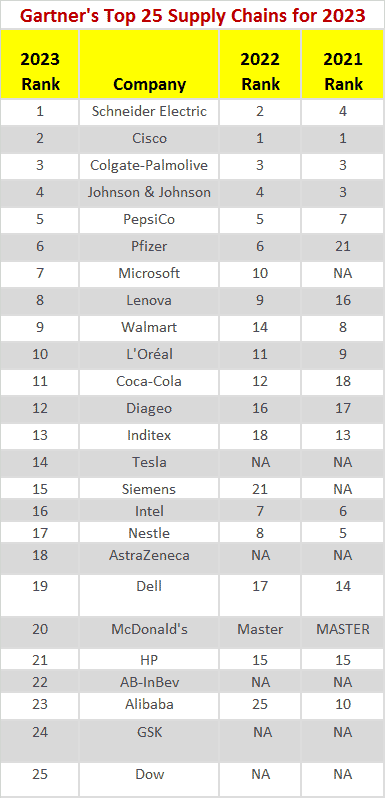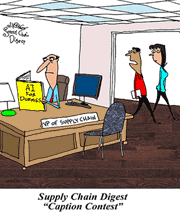Understanding the Gartner Top 25 Supply Chains 2023
My question this time each year: What are the best supply chains in the world?
The reality is there is no way to determine that, absent an incredibly detailed study of leading icandidates that would even then lead to potentially dubious results and certainly be obsolete by the time the research was finished. Or, we could look at the Gartner top 25 supply chains list.
That famous ranking used to be released at a dinner the Gartner Supply Chain Executive Conference in May (now the called the Supply Chain Symposium), but this year it was released in a webinar two weeks after the conference.
Let's take a look.
| GILMORE SAYS: |
WHAT DO YOU SAY?'
Is the process perfect? Certainly not. The unstated assumption is, for example, that stellar financial results equals supply chain excellence.
Send us your
Feedback here
|
The former AMR Research brilliantly came up with the top 25 idea in 2004. Gartner then acquired AMR in 2010. Over the last few years, the concept has been extended, so that we now have a "Next 25," plus the top 25 healthcare, industrial, and consumer goods supply chains, etc.
At previous Gartner conferences, when asking around a bit, I found - not surprisingly - that very few supply chain practitioners have any real idea how the list is determined. They only know if they are in or they are out, and that's about all that matters.
This year Schneider Electric came out on top for the first time - sort of.
I put it that way because again in 2023, Apple, Procter & Gamble, Amazon, and Unilever were left off the formal top 25, as those four companies have been placed in a separate relatively category called "supply chain masters," a sort of supply chain hall of fame. To get there, Gartner says a company needs to have attained top-five composite scores for at least seven out of the last 10 years.
This means Schneider might really be rated as anywhere from the first to 5th best supply chain, if the master companies were included.
By the way, long time Master McDonald's was not a member this year, for reasons not clear, but is in the top 25.
Why does Gartner do this? It frankly may have to do with in effect getting more companies in the top 25 plus the new masters category combined - Gartner clients like that recognition, of course. It may also allow the top 25 list to appear a bit more dynamic.
As I have said before, I find the masters list idea a little goofy, but so be it.
With Amazon, Apple, P&G, and Unilever withdrawn from the competition, the rest of the top 10 after Schneider Electric was (2) Cisco; (3) Colgate-Palmolive; (4) Johnson & Johnson; (5) PepsiCo; (6) Pfizer; (7) Microsoft; (8) Lenova; (9) Walmart; and (10) L'Oreal.
Four new companies made the Supply Chain Top 25 this year versus 2021, those being: Tesla, AB-InBev, GSK, and Dow (plus McDonald's).
Falling out of the top 25 were Nike, BMW, Abvie, General Mills and Britsh-American Tobacco.
Below is a chart of this year's Top 25, also with where each company placed in the previous two years (NA means not in the top 25 that year).

So, you ask, how on earth is the top 25 determined?
Gartner said it starts with the Fortune 500 list of top US companies by revenue and the Forbes global 2000 list that basically does the same thing on a worldwide basis. It then eliminates a lot of those companies because they do not much operate what most of us would think of as a real physical supply chain - companies in banking, insurance, software, and many more.
What's more, the minimum revenue to be included in the final evaluation list was again an amazing $12 billion. The end result is usually about 300 candidates.
From that culled list, Gartner analyzes publicly available financial data, specifically looking at three metrics from 2022 financial reports:
Return on physical assets (ROPA): Net income / total physical assets
Inventory turns: Cost of goods sold / inventory levels
Revenue growth: Change in revenue from prior year
Revenue growth and RPA use a three-year weighted average, meaning the most recent year gets the most weight and the two prior years somewhat less. Inventory turns, smartly, uses the prior year's quarterly average (reducing impact of end of year games).
In addition, from an"objective" data perspective, Gartner uses mostly external rating data to calculate a score for ESG (Environmental, Social, and Governance), but now also ( think new) including some kind of analyst input.
The three financial metrics plus the ESG score combine to represent 50% of the total score. This year Gartner did not specify the weighting, but in the past it's been 20% of the whole composite score for ESG, 15% for ROPA, 10% for inventory grow and 5% for inventory turns.
Regardless, this formula gives a tremendous advantage to some companies, such as Amazon given its huge usual revenue growth or McDonald's and its 175 or so inventory turns per year. It also penalizes companies like a Home Depot or a Lowes, for example, which are only going to have turns in the mid-single digits at best, because of their need to stock every item under the sun to meet customer service targets, many of which are very slow movers.
In general, this approach also penalizes a company within a given sector that strategically decides on a higher service, lower turns strategy (even though we can all agree that inventory efficiency is a very important attribute of supply chain excellence). It also gives an advantage to companies that are aggressive acquirers in terms of the revenue growth factor.
Companies that have heavily outsourced production and distribution also have an inherent advantage. Why? Because they have chosen to shed assets, and that often drives their ROPA metric higher. While outsourcing can be a very smart thing for many reasons, it does not inherently improve a supply chain. This metric also discriminates against asset-intensive businesses, such as chemicals and automotive. That is in part why we see only four such industrial companies (Schneider Electric, Siemens and Dow and Tesla) in the top 25.
So, at this point, you must be a very large and public company to be considered in the analysis. Private companies do not have the public financial data needed for this part of formula and cannot make the list.
Another 25% of the final rankings come from so-called "peer opinion." For 2023, this consisted of an un-specifid number napparently very influential respondents who first select a group of 25 companies from the master list of about 300 that they believe are highest in terms of supply chain maturity. This is an important change - in recent years, the criteria was what companies were doing the best job of being a "demand-driven value network orchestrator" - not exactly a commonly understood concept.
As a note, you must apply to be one of these supply chain voters, and be a supply chain professional, not a consultant, but last year academics were allowed.
From those selections, respondents are then asked to rank those companies from first to last, from which points are assigned to the companies selected based on how they are scored across respondents.
The final 25% of the composite score came from votes from an unknown number of Gartner's own supply chain analysts. They use the same tool and criteria that the peer group does in ranking company supply chains.
Take the financial rankings plus ESG scores, and the votes from the peer and Gartner analyst groups and voila, out spits the top 25 in something like a mathematical fashion.
Is the process perfect? Certainly not. The unstated assumption is, for example, that stellar financial results equals supply chain excellence. Only very large companies are considered. Who really knows how good/mature most other company supply chains are? And it seems clear to me that working with Gartner and even better speaking at the supply chan conference always has a beneficial effect on a company's placement.
So, with all that, here in general is the advice I give to companies hoping to crack the top 25: (1) understand the methodology, especially with regard to the financial data. Not much you can really do about that, but you can at least understand how it works and do some comparisons to key competitors; (2) encourage others outside your organization to participate in the peer review process and rate you highly; and (3) most important, if you are really serious about this, arrange "briefings" and/or written submissions to Gartner analysts touting what you are doing in supply chain in the same way that technology vendors do.
And speak at the conference.
The Gartner top 25 supply chains - it has many faults, but it is the best we've got. I look forward to it every year. It certainly stirs the pot - but there must be a better way. Or maybe not.
What do you think of the Gartner Top 25 2023 supply chain list and methodology? How could it be done better? Let us know your thought at the Feedback section below.
|











